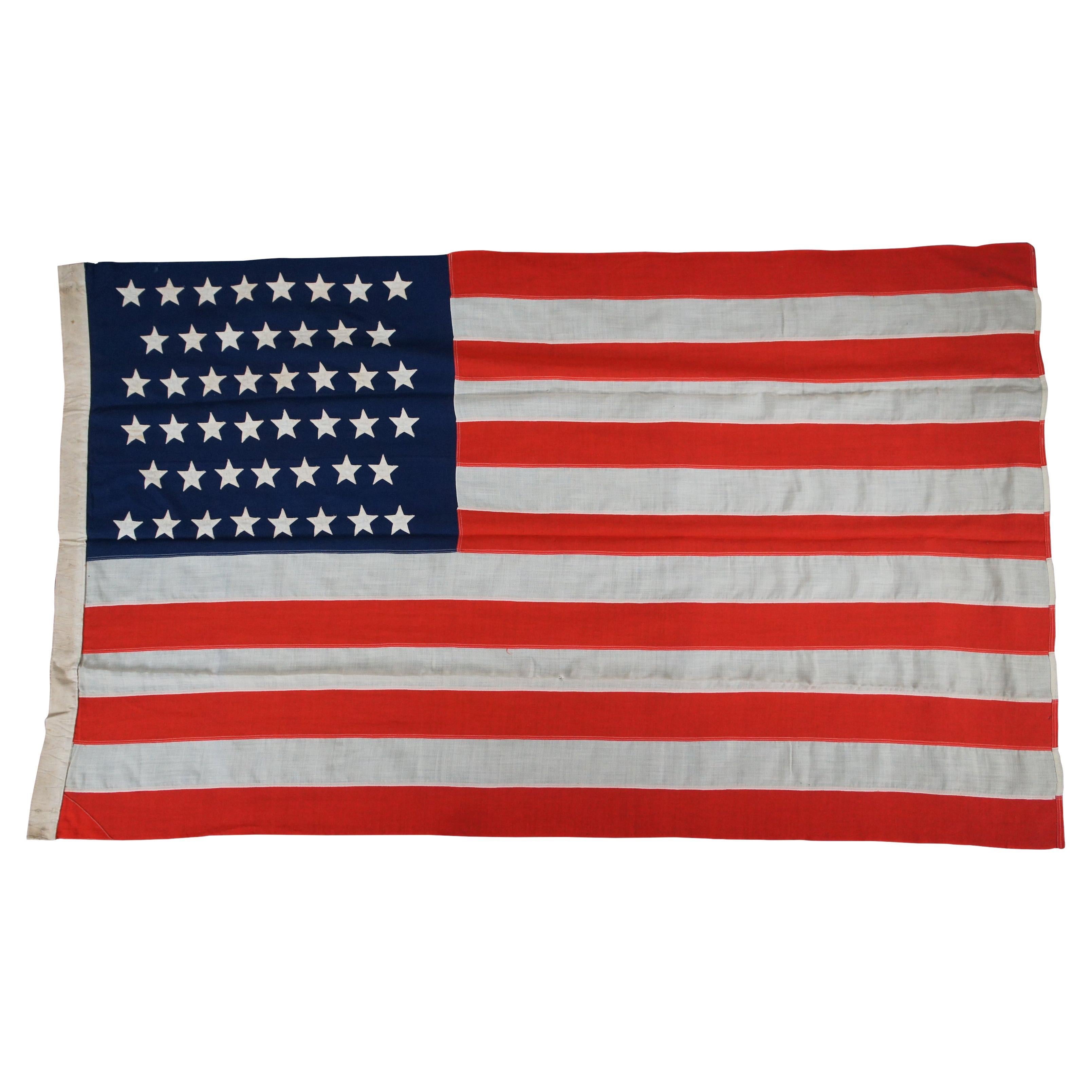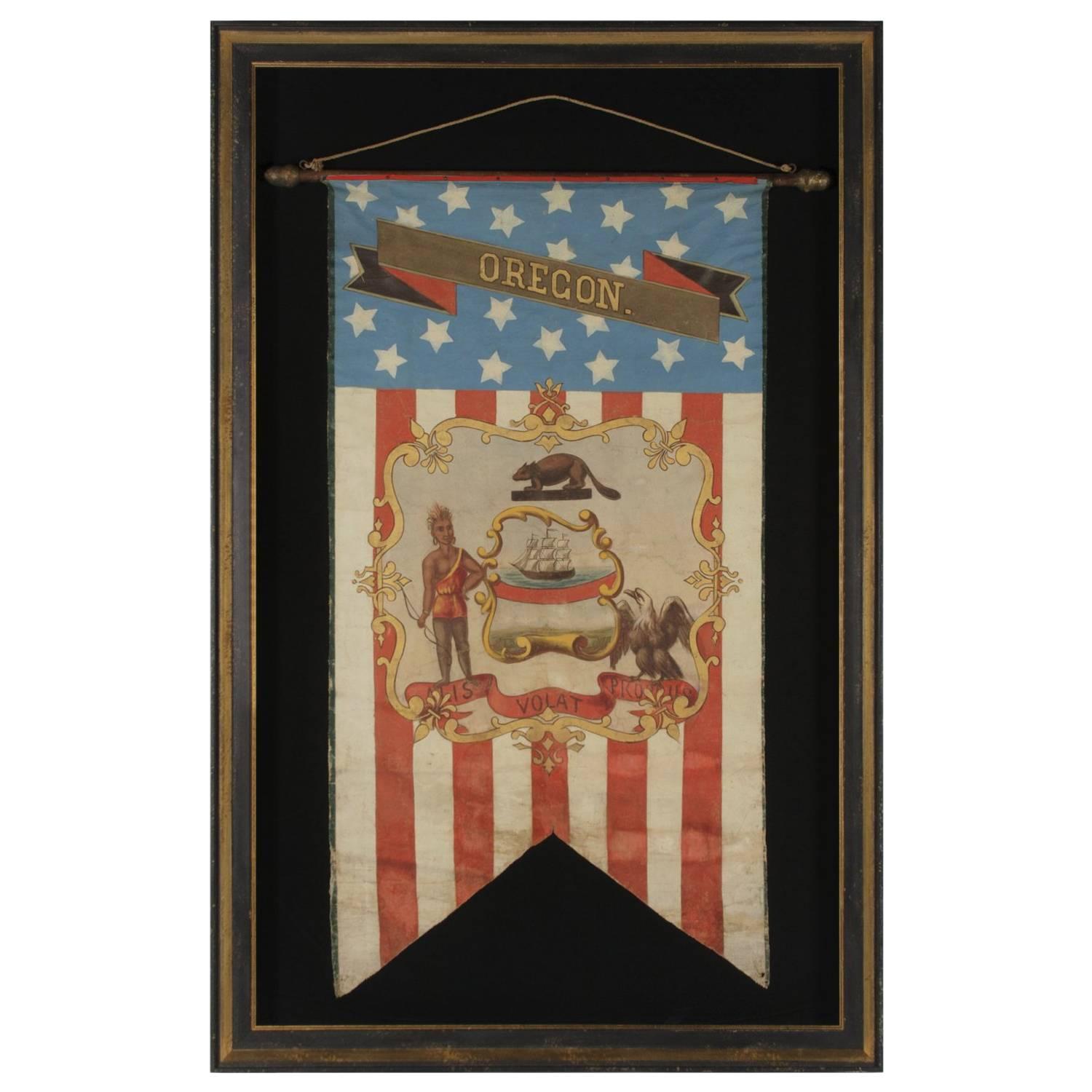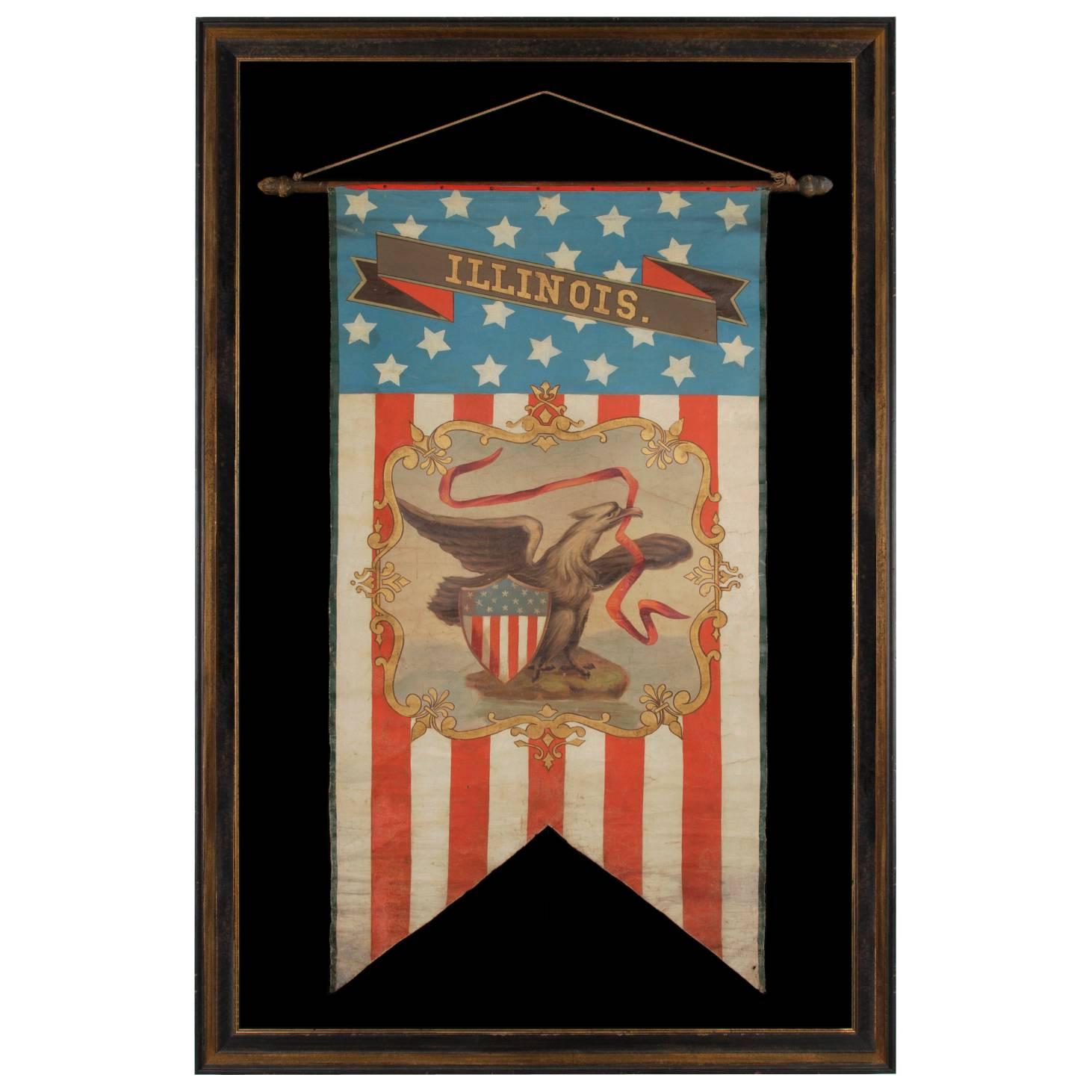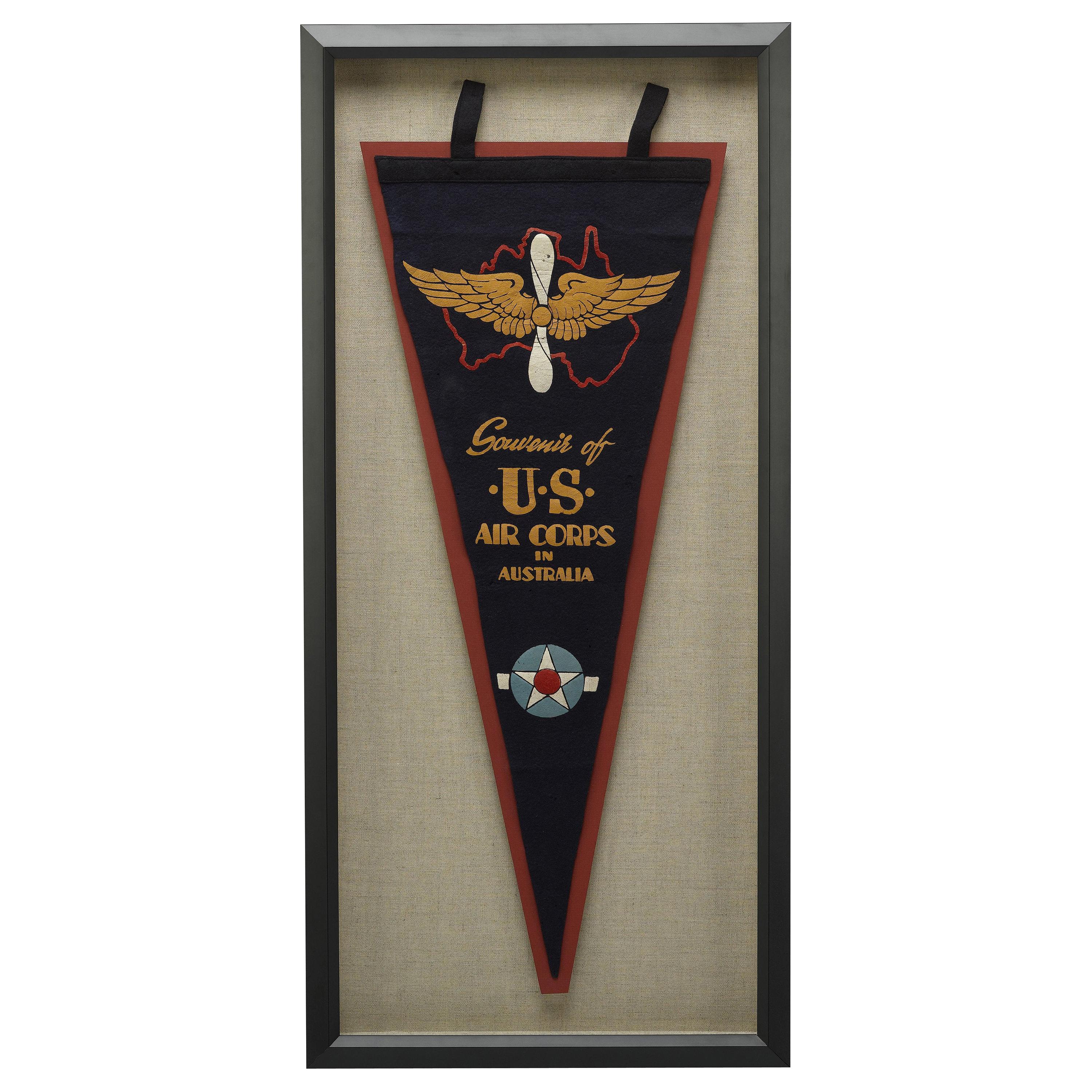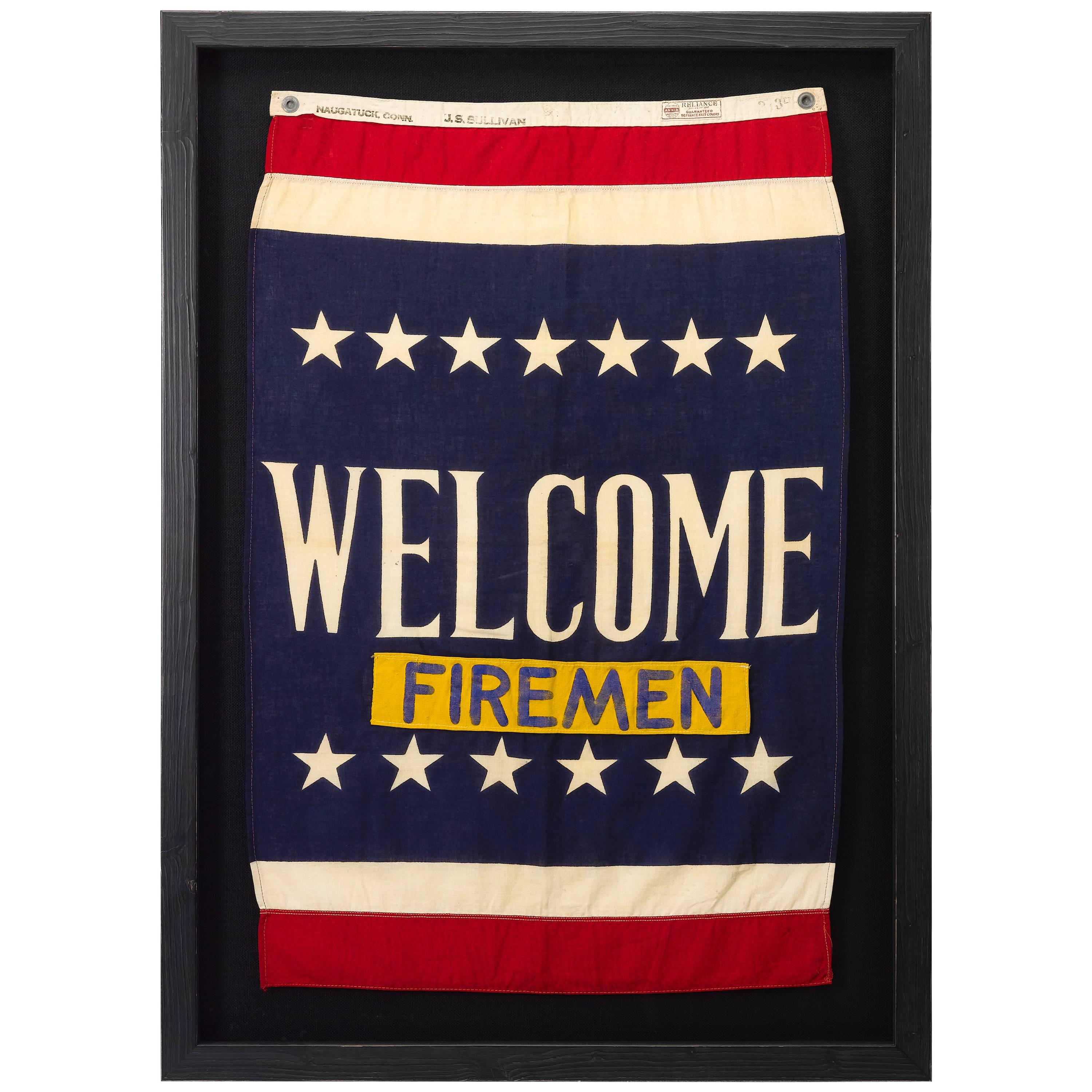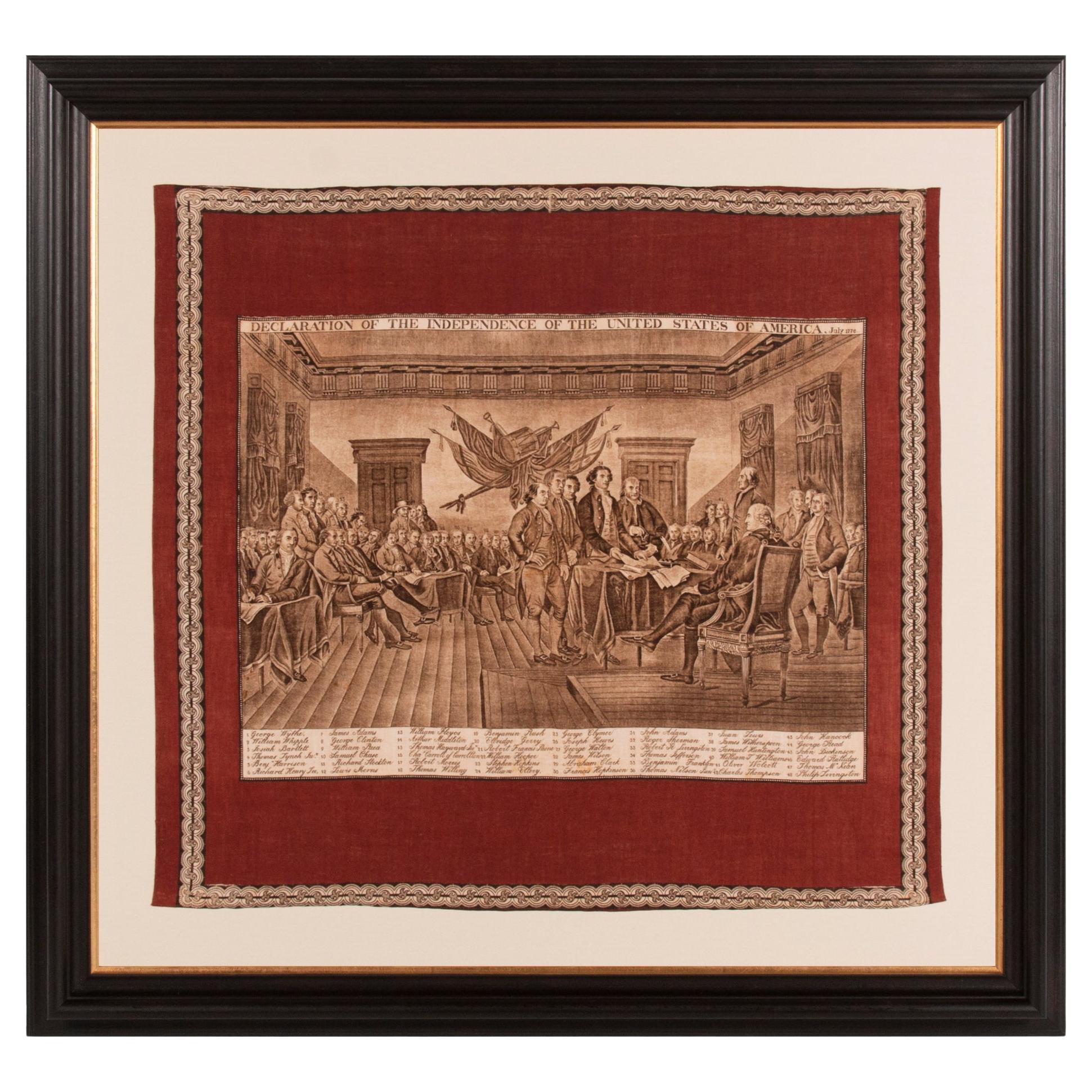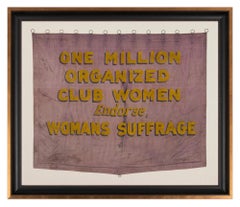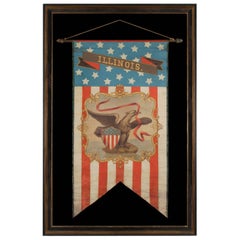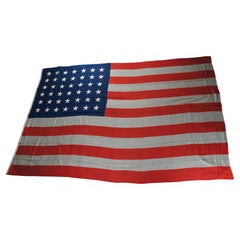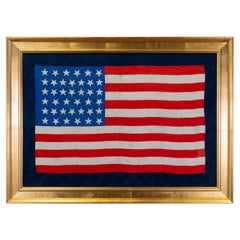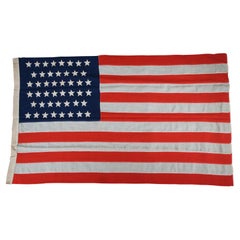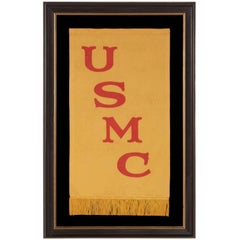
Rare United States Marine Corps Banner of the 1910-1920 Era
View Similar Items
Want more images or videos?
Request additional images or videos from the seller
1 of 5
Rare United States Marine Corps Banner of the 1910-1920 Era
About the Item
- Dimensions:Height: 46.75 in (118.75 cm)Width: 30 in (76.2 cm)Depth: 2.5 in (6.35 cm)
- Place of Origin:
- Period:1910-1919
- Date of Manufacture:1910-1920
- Condition:See Item Description.
- Seller Location:York County, PA
- Reference Number:Seller: pat-4991stDibs: LU84978611533
About the Seller
5.0
Recognized Seller
These prestigious sellers are industry leaders and represent the highest echelon for item quality and design.
Established in 1991
1stDibs seller since 2008
61 sales on 1stDibs
Typical response time: 10 hours
More From This SellerView All
- Violet & Yellow Suffragette Parade Banner, Ca 1910-1920Located in York County, PARare violet & yellow Suffragette parade banner, the plate example illustrated in the text reference on the subject, made ca 1910-1920. Hand-painted banners...Category
Early 20th Century Political and Patriotic Memorabilia
MaterialsSilk
Price Upon Request - Hand-Painted Patriotic Banner With The Seal of the State of IllinoisLocated in York County, PAHAND-PAINTED PATRIOTIC BANNER WITH THE SEAL OF THE STATE OF ILLINOIS AND GREAT FOLK QUALITIES PROBABLY MADE FOR THE 1868 DEMOCRAT NATIONAL CONVENTION...Category
Antique 1860s North American Political and Patriotic Memorabilia
MaterialsCanvas
Price Upon Request - Hand-Painted Patriotic Banner with the Seal of the State of OregonLocated in York County, PAHAND-PAINTED PATRIOTIC BANNER WITH THE SEAL OF THE STATE OF OREGON AND GREAT FOLK QUALITIES, 1861-1876: Swallowtail format, patriotic vertical banne...Category
Antique Late 19th Century American Political and Patriotic Memorabilia
MaterialsCanvas
Price Upon Request - Hand-Painted 19th Century Banner with the 1867 Proposed Seal of IllinoisLocated in York County, PAHAND-PAINTED 19TH CENTURY BANNER WITH AN 1867 VERSION OF THE SEAL OF THE STATE OF ILLINOIS, PROPOSED IN THAT YEAR BY THE SECRETARY OF STATE, BUT IN A VARIATION NEVER FORMALLY ADOPTED Banner with the Illinois State Seal, in a rare variation of the design, never adopted. In 1867 Illinois Secretary of State Sharon Tyndale proposed that the phrases in the state motto be reversed. In the wake of the Civil War, (which ended in 1865,) Tyndale suggested that the verbiage be changed from "State Sovereignty--National Union" to "National Union--State Sovereignty,” which made sense given the recent secession of the Southern States, which placed their own interests first. Illinois' own Abraham Lincoln had worked hard to preserve national interests, echoed here in the altering of the language. Though Tyndale’s suggestion was rejected, he was nonetheless charged with creating a new design, which he did and was soon adopted. This displayed the dates of "1818," when Illinois became a state, and "1868," when the seal was officially changed. Interestingly enough, Tyndale did manage to send a message in the new version by turning the word “sovereignty” upside-down , with the surmised explanation that this fit accordingly with the orientation / position of the streamer. The banner is beautifully hand-painted on muslin and retains its original staff. The shape is beautifully scalloped at the bottom edge, which is painted to look as if there is an applied fringe. Most of the elements are congruent with the 1868 version, but there are various differences. Set within a shield-shaped medallion—usually circular—is the expected eagle in a side view, spread wing pose with beak uplifted. The eagle is supposed to be perched upon a rock with one talon, while gripping a Federal shield in the other. Here there is no rock and both talons grip the shield, which displays 13 stars. Note the date of "1867" and Tyndale's preferred order of the wording on the billowing ribbon in the eagle's beak. The foreground of the official design is all grass. Here there are olive branches—a peacetime reference appropriate for a country recovering from war—on a grassy area, set upon a sandy shore before Lake Michigan, with a rising sun on the horizon. Mounting: The banner was mounted and framed within our own conservation department, which is led by masters degree trained staff. We take great care in the mounting and presentation of flags and have preserved thousands of examples; more than anyone worldwide. The background is 100% cotton twill, black in color. The mount was placed in a black-painted, hand-gilded and distressed Italian molding. A shadowbox was created to accommodate the staff. The glazing is U.V. protective plexiglass. Feel free to contact us for more details. Banner - 49" x 56.5" Frame - 67.75" x 59.25" About Jeff R. Bridgman Antiques, Inc.: As an advisor to top museums and collectors alike, Jeff Bridgman is the world's leading expert and source for antique American flags and political textiles...Category
Antique 1860s American Political and Patriotic Memorabilia
MaterialsCotton
Price Upon Request - Patriotic Silk Kerchief w/ 34 Star Flags & an Image of Washington, Civil War EraLocated in York County, PAPATRIOTIC SILK KERCHIEF OF THE CIVIL WAR PERIOD, WITH AN ENGRAVED IMAGE OF GEORGE WASHINGTON, CROSSED 34 STAR FLAGS, AN EAGLE, AND "UNION FOREVER" SLOGAN: Patriotic kerchiefs that date prior to the 1876 Centennial of American Independence are rare among surviving 19th century textiles. Printed on silk and made during the opening years of the Civil War, this example consists of a white ground with red and blue borders. Inside is a prominent, copper engraved, device that consists of a large image of George Washington, crowned by a spread winged eagle that grasps a billowing streamer in its beak and talons. The ribbon boasts the Federal sentiment "Union Forever." The likeness of Washington is derived from Gilbert Stuart's Athenaeum portrait. Below this is a facsimile of Washington's signature, cradled by crossed American flags, each with 34 stars arranged in circular medallions. Although political textile historian Herbert Ridgway Collins associated this kerchief with the centennial of American independence,* there is overwhelming evidence that it was produced earlier. The large scale is much more indicative of kerchiefs produced in the 1860's and prior. Made of silk, the binding is hand-stitched, which is also common of those produced before 1876. When these facts are added to the pro-Union Civil War slogan and flags in the 34 star count, the combination of all these factors points firmly to Civil War period manufacture. Kansas was admitted into the Union as the 34th state on January 29th, 1861, about two-and-a-half months before the Confederate assault on Fort Sumter that marked the beginning of the Civil War. The 34th star was officially added on July 4th of that year and the star count remained official until July 4th, 1863. Further evidence can be found in an example of this kerchief that resides in the collection of the Adams County, Pennsylvania Historical Society, with firm provenance to a woman by the name of Emma Yount. The story goes like this: “With the Battle of Gettysburg looming and the countryside in turmoil, the Union cavalry rode into Gettysburg on the afternoon of June 30, 1863. The troopers dismounted and lounged in the town while awaiting further orders. During that time, the seven year old daughter of innkeeper Israel Yount, Emma, was playing outside their home when a cavalryman asked her to come and visit with him while he was resting. The cavalryman told her that he missed his young daughter at home and asked if little Emma would hug and kiss him on the cheek to remind him of his daughter, who he felt he might not ever see again. Emma asked her mother if she could do as the cavalryman suggested, and her mother considered the circumstances and allowed Emma to do so. Before leaving, the cavalryman gave young Emma a silk handkerchief he was carrying that featured George Washington's image and patriotic border and flags. Emma kept that handkerchief until her death in 1946 and it was then donated to the Adams County Historical Society.” The trio of brass rings, hand-sewn along the top edge, would have been added by a former owner so that it could be hung vertically. The textile itself is both beautiful in design and rare. Outside of an example pictured by Collins in his book “Threads of History” (Smithsonian Press, 1979), and the copy in the Adams County Historical Society, only three others like it are known to have surfaced, including this example. This condition is excellent for the period and it survives as an exceptional relic of the War Between the States. It is of interest to note that kerchief bears marked similarities to another, especially rare, pro-Union variety, that was produced in London for the American market. Notably larger in scale, but very much alike in terms of the fabric, the printing, the shades of red and blue, the verbiage, and the general overall graphic feel, it was produced by Foster & Porter, a known, English maker of printed kerchiefs. Instead of featuring George Washington, the imagery centers on a large cannon...Category
Antique 1860s American Political and Patriotic Memorabilia
MaterialsSilk
- Large Scale Printed Kerchief of the Signing of the Declaration of IndependenceLocated in York County, PARare, large scale Kerchief with a beautifully engraved image of John Trumbull’s “declaration of independence,” likely made in...Category
Antique Mid-19th Century American Political and Patriotic Memorabilia
MaterialsCotton
You May Also Like
- Rare Monumental 1890 Antique 42 Star United States of America FlagLocated in Dayton, OHMonumental fifteen foot 42 star American flag, circa 1889-1890. The 42-star flag is rare because only a limited number of 42-star flags were produced after Washington became a state on Nov. 11, 1889. But it takes a more intimate knowledge of flag trivia to know just why it happened this way. White stars are added to the blue field of the star-spangled banner on the Fourth of July after a state is admitted to the union. In the fall of 1889, several western territories became states. Dakota was admitted, and then split into North and South Dakota, on Nov. 2, 1889, which made them state and star numbers 39 and 40. Montana was named the 41st state on Nov. 8, followed by Washington, on Nov. 11. Only a few flag manufacturers began producing 42-star flags before the official addition of the 42nd star on July 4, 1890. Those who tried to jump the gun by being the first to produce an up-to-date flag were surprised when Idaho was admitted to the United States on July 3...Category
Antique 1890s American Classical Historical Memorabilia
MaterialsCotton
- 1889 North Dakota 39 Star United States of America Statehood FlagLocated in Coeur d'Alene, ID39 star silk statehood flag. 23 1/2" x 15". Was the unofficial North Dakota Flag. As South Dakota was also admitted as the 40th state on the same day this...Category
Antique 1880s American Historical Memorabilia
MaterialsSilk
- Antique 46 Star WMH Horstmann Company United States of America Flag 83"By HorstmannLocated in Dayton, OHAntique forty six star large wool American flag by Horstmann Company, circa 1908-1912. Horstmann firm was founded by William H. Horstmann (1785-1850), who had immigrated to Philadelphia from Germany. Horstmann bought out a local swordmaker in 1828 and thereafter entered the military goods field. The firm benefitted from the Civil War, becoming the largest military goods supplier in the nation by 1864. WILLIAM H. HORSTMANN & SONS, Manufacturers of Dress Trimmings and Military Goods. 5th & Cherry Streets, Philadelphia, PA. This house was founded, in 1815, by William H. Horstmann, a native of Cassel, in Germany. He had learned the trade of silk-weaving in France, and, emigrating to the United States in the above-mentioned year, established himself in Philadelphia as a manufacturer of fringe, laces and trimmings of various kinds. He married the daughter of Frederick Hoeckly, a German settler in Philadelphia, and also a manufacturer of fringe, coach-lace and tassels. He devised several improvements in this trade, especially by introducing varieties in the styles and patterns of this class of goods, there being at that time only two patterns used in the trade, which were known as the Jefferson pattern and the Monroe pattern. In 1824, he introduced into this country from Germany the use of plaiting or braiding machines, and about the same time he was the first to introduce into this country the use of the Jacquard loom, for weaving patterns in textile fabrics. His location was in the first instance at No. 50 North Third street, but within a short time he removed to a store next to the Harp and Crown tavern, afterwards known as the City hotel, and continued his business within a short distance of this point for many years. In 1828, he commenced the manufacture of military trimmings as a special department, and this branch has grown to most important proportions, Horstmann's military goods being in demand throughout time country. The firm have also executed large Government contracts in this line for the War and Navy Departments. In 1831, he established a branch house in New York city, and about the same time erected a factory at the corner of Germantown road and Columbia avenue. The factory was continued here until time erection of the extensive building at Fifth and Cherry streets, where the works, salesrooms and offices of time firm now are. This massive structure is six stories high, and extends 140 feet on Fifth street and 200 on Cherry street, and reaches back to Race street. The separate departments into which the business is divided are thirty in number. More than 1000 distinct looms and machines are in use in the building, many of them very costly and some invented and used exclusively by this firm, the motive power being supplied by a steam engine of fifty horse power. The area covered by the works is about 11,000 square feet. Time number of hands employed is very large, about 500. When the erection of a vast factory at this point was first proposed, a strong opposition was made by time holders of the neighboring property. The ancient German Lutheran Church and burying ground, since removed, stood opposite the site, and a bill was introduced into the Legislature to forbid the use of a steam engine within 100 yards of any place of worship. The interests which such a bill would have affected injuriously, especially those of several newspapers, roused a strong opposition to it, and it failed to become a law. In 1845, William H. Horstmann, the founder of the house, retired from the business, and his two sons, William and Sigmund, assumed the management and it was under their direction that the new building, above described, was erected. The goods produced by this house are of almost endless extent and variety. They include goods woven from all the various textile fibres—cotton, wool, silk, etc.—in every style, color and pattern, and are used for an infinite number of purposes. Narrow woven goods are time staple production, made up into material for dresses for both sexes, for use in daily life, and for regalia for ""societies;"" for the costumes of the stage, the upholstering of houses and of carriages, the uniforms of soldiers, together with equipments for the same, and for funeral purposes. The raw material used in the manufacture is to a great extent very costly, and their store rooms often hold as much as $200,000 worth of goods in an unworked state. There are two rooms devoted to power looms in the factory, one for coach lace and one for other styles of weaving, in which about 250 of these machines are constantly running. The braiding machines in the coach lace room are very noteworthy. The cord to be covered with braid is drawn through an opening in time middle of a flat, circular, metallic plate, about 15 inches across. Up to a point on this cord, about a foot above the plate, the threads of the braiding material converge, like the ribs of a tent-roof, and there weave in and out and out and in, as the coating of braid grows, and time covered cord rises and is wound away above. The weaving is accomplished by the motion of the spools below that carry the different threads of the braid. These spools stand in uprights, which are carried round and amongst each other in curved slots in the above-mentioned broad metallic plate. All but two of these spools run in and out among each other, with a swift, easy and intricate motion, mind so rapid that time eye can hardly follow it, while one or two special spools run steadily round and round among time twisting spools with the most extreme swiftness. Many other machines, displaying equally ingenious mechanism, are used in the factory. The various details of equipment manufactured and supplied by this house are also important, both for their number and the superior quality of the manufacture. The one article of swords may be taken as an instance. This trade grew naturally and immediately out of the established army and navy goods department of the works, it being necessary that the sword itself should be furnished together with the sword-belt and other trappings all complete. Every part of the sword and trappings, with the exception of the blade, is made on the premises. The blades are almost all imported from the ancient German sword-blade emporium of Solingen, where, it is said, swords have been made ever since the year 1147, when Count Adolphus of Berg brought home from the East and established there the business of forging Damascus blades. There is in this department a stock of some thousands of blades, of many different patterns and sizes, ready to be set and finished. Any style or sword can be had from this warehouse, from the plainest kind up to a presentation sword...Category
Vintage 1910s American Classical Political and Patriotic Memorabilia
MaterialsWool
- Souvenir of the War 1914-15-16-17-18 BannerLocated in Colorado Springs, COPresented is a stunning textile banner from the first World War, dating to 1918. The square tan cotton cloth is embroidered with two crossed flags, the ...Category
Vintage 1910s Australian Political and Patriotic Memorabilia
MaterialsCotton
- US Air Corps in Australia Vintage Military Pennant, circa WWIILocated in Colorado Springs, COPresented is a souvenir felt pennant celebrating the servicemen and women of the U.S. Air Corps who were based in Australia and fought alongside members of the Royal Australian Air Force during WWII. The navy pennant features a printed red outline of the Australian continent with the U.S. Air Corps “wings” superimposed on it. Below, the text reads, “Souvenir of U.S. Air Corps in Australia.” At the very bottom of the pennant is the U.S. Air Corps symbol. Framed according to archival standards, this pennant symbolizes the collaborative partnership between the United States and Australia during the height of the Second World War in the Pacific Theater. Following the swift Japanese conquest of the Philippines and East Indies in late 1941, the remaining servicemen of the United States Army Air Force in the Pacific eventually relocated to Australia, to join other US and Australian units, including the Fifth Air Force, and regroup. The Fifth Air Force was placed under the command of Major General George Kenney in July of 1942. Their new goal was to seize air superiority over New Guinea and gain back air coverage over the Solomon Sea. General Kenney worked with U.S. Army General MacArthur...Category
Vintage 1940s Australian Historical Memorabilia
MaterialsFelt
- Vintage WWII U.S. Navy Patriotic Banner, "Welcome Firemen" Flag, circa 1941-1945Located in Colorado Springs, COThis is a beautifully preserved WWII Navy aircraft carrier banner, emblazoned with a welcome for the ship's firemen. The banner is partially printed and has sewn elements. The flag's field is dyed a rich navy blue, with a resist dyed white stripe and a sewn red stripe at both top and bottom. A large "WELCOME" is resist dyed at center, in big white letters. This is followed by a sewn yellow strip of contrasting fabric, printed with the word "FIREMEN" in blue. Thirteen white stars complete the design of this patriotic piece of WWII and Navy history. The banner retains its original white hoist, with two metal grommets on each side, for ease in display on the ship. Along the center of the hoist is the printed name of "J.S. Sullivan." "Naugatuck, Conn." is printed along the left and the size "2 x3 FT" is printed along the right. The flag maker, Annin, has sewn in its label, boasting "guaranteed defiance fast colors." CONDITION: Very good condition, considering age and past use. Partially printed and hand-sewn flag construction. Some toning to the white of the flag and along the top hoist. Original grommets at left and right of the hoist. The flag measures 36" X 22". Expertly framed on black linen with an antiqued black wood...Category
Vintage 1940s American Political and Patriotic Memorabilia
MaterialsLinen
$2,500 Sale Price36% Off



